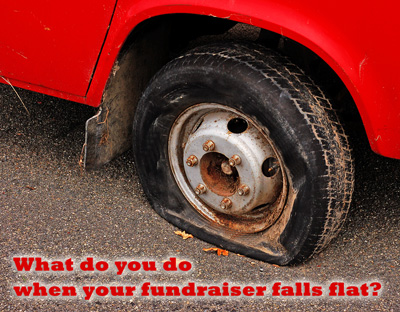 You decide to raise money for something very tangible. It seems like a good idea, because you hear that donors like to make specific things happen. So you pick that thing you’ll raise money for, launch the campaign, and . . . you don’t meet the goal. Now what?
You decide to raise money for something very tangible. It seems like a good idea, because you hear that donors like to make specific things happen. So you pick that thing you’ll raise money for, launch the campaign, and . . . you don’t meet the goal. Now what?
That’s the question facing Laura Lamorette, marketing & communications coordinator at EarthDance. Here’s what she emailed me last week . . .
“I attended your webinar on end-of-year giving email campaigns. My organization launched one for the first time this year. It was fairly successful (we even got two media spots based on the content of the letter!).
But, we did not reach our intended goal for money raised. We specified a need with a specific cost: a tractor for our nonprofit teaching farm. It was a high bar we set, and we only raised about 25% of our goal.
My question is how we report this back in an update. I know we do not want it to seem like a failure. I don’t believe we should continue to try and raise funds, right? So what approach should we take to thank everyone who did donate, and to report on the status. We obviously can’t buy the tractor with the money raised.”
As I told Laura, this is a common conundrum: how do you give donors the specificity they want while still leaving your nonprofit the flexibility it needs? Some nonprofits are very carefully wording their appeals so that gifts are technically unrestricted even when using specific details in appeals. It can be a very delicate balance.
Given the fact that she was very specific about the tractor, I told Laura that I thought she had two options:
1) Continue to fundraise for the tractor, and just expand the time horizon to something more realistic. Come up with some additional campaigns that will add to the “tractor fund.” This may include getting some bigger contributors to provide matches — e.g. “Joe Smith will contribute up to $XXXX toward the tractor, but only if you contribute $50 today.” I suggested that she get some major donors involved to narrow the gap before more broadly asking for funds again.
2) If you want to forget about the tractor, go back to your tractor donors and tell them that you didn’t meet the goal, but have a wonderful Plan B that allows you to do something very similar. The important thing is to honor the donor’s intent in helping you achieve the mission. Most donors will probably be OK with the change as long as you have a compelling explanation with a similar goal. However, in this case, if someone were to say, “Hey, I want my money back because you aren’t getting a tractor” then EarthDance is ethically obligated to return the donation.
I wanted to see how several smart fundraisers I know would have approached Laura’s question, and here’s what they had to say . . .
Tom Ahern, my favorite direct mail and donor newsletter writer
This is a huge opportunity to re-solicit. And re-solicit. And re-solicit … until goal is made. The basic message comes from the email itself. “It was a high bar we set. And we didn’t know how much we could raise from just one letter … and we were pleasantly surprised. We got a full 25% of the way there….” In other words, don’t treat it as a failure, treat it as a first step in a journey toward a goal. This is a campaign, not a letter. People like edging up on a goal. They’ll keep giving. Just bring that tractor to life. What will it do out there in the world?
When they sought to fund a tractor, they crossed a border, from “single appeal country” to “capital campaign country.” A tractor is a piece of capital equipment. It requires a large sum. Capital campaigns take repeated asks over time … and most of the money is raised in peer-to-peer, face-to-face asks, not through the mail.
Jeff Brooks, my favorite fundraising blogger, because he says it like it is
What I’d do: Write back to all the people who gave. Tell them you didn’t reach the goal and can’t buy the tractor. Offer them their money back. Or, if they prefer, they can give more and perhaps we’ll reach the goal. Also give them a third choice: to give you permission to use the funds for something other than the tractor (Make it a fairly soft ask; it really needs to be their choice.) At the same time, send another message to everyone else (all the people you emailed the first time who didn’t respond) and tell them we’re still hoping to get that tractor, we’re XX% of the way to having enough.
NOBODY will want their money back. But your offer will catch their attention in a way fundraising messages seldom do.
Gail Perry, my favorite fundraiser who gets boards fired up to help
I’d be inclined to find a donation source to match future gifts on this project. I would not say we only raised 25% of the goal. I’d just say we are “well on our way” to the goal but still need more help. I wonder if they were appealing to a “warm” audience or if this was sort of cold? That might explain the tepid response.
Sandy Rees, my favorite fundraiser for small and start-up nonprofits
Congratulations on launching your first email campaign! It sounds like you were quite ambitious in going after money for a tractor (those aren’t cheap). Since you’ve started down this path and people expect you to be successful, I wouldn’t stop raising money for it. You still need the tractor, right?
Take a little time to develop a plan for going after the rest of the money you need. In your update to your donors, be truthful and let them know how much was raised, and that you have a plan for raising the rest. That will help build confidence for your donors in your organization.
If you give up on the tractor at this point, it will do a lot of damage to the relationship you have with your donors, and you’ll likely lose many of them. No one wants to give money to an organization that isn’t successful. And next time, use your email campaign to raise money for ongoing operations. Then, no matter how much you raise, you won’t have to deal with this situation again.
Marc Pitman, my favorite fundraiser for making fundraising feel easy
While I definitely understand your disappointment in falling so far from the mark, I think the best way to report this is as a huge success.
I’d be as enthusiastic as possible. Something like this:
This was our first ever online effort and you came through! We raised 25% of the cost of a tractor for the teaching farm. Thank you so much!
[insert picture of a tractor with only 25% filled in]
Since a 1/4 tractor doesn’t do much work around the farm, we want to raise enough to get a whole tractor.
I’d make sure it has a line about how important the tractor is to the students. And I’d run the remaining cost of the tractor through GiftRangeCalculator.com to identify some different gift levels to get you to that goal.
Finally, I’d report this back in print and in email. Email is great, but for fundraising, the power is in multi-channel communication. And make sure it is full of gratitude and enthusiasm!
Now it’s your turn . . .
What would you do if your were Laura? Share your ideas and experiences in the comments.





